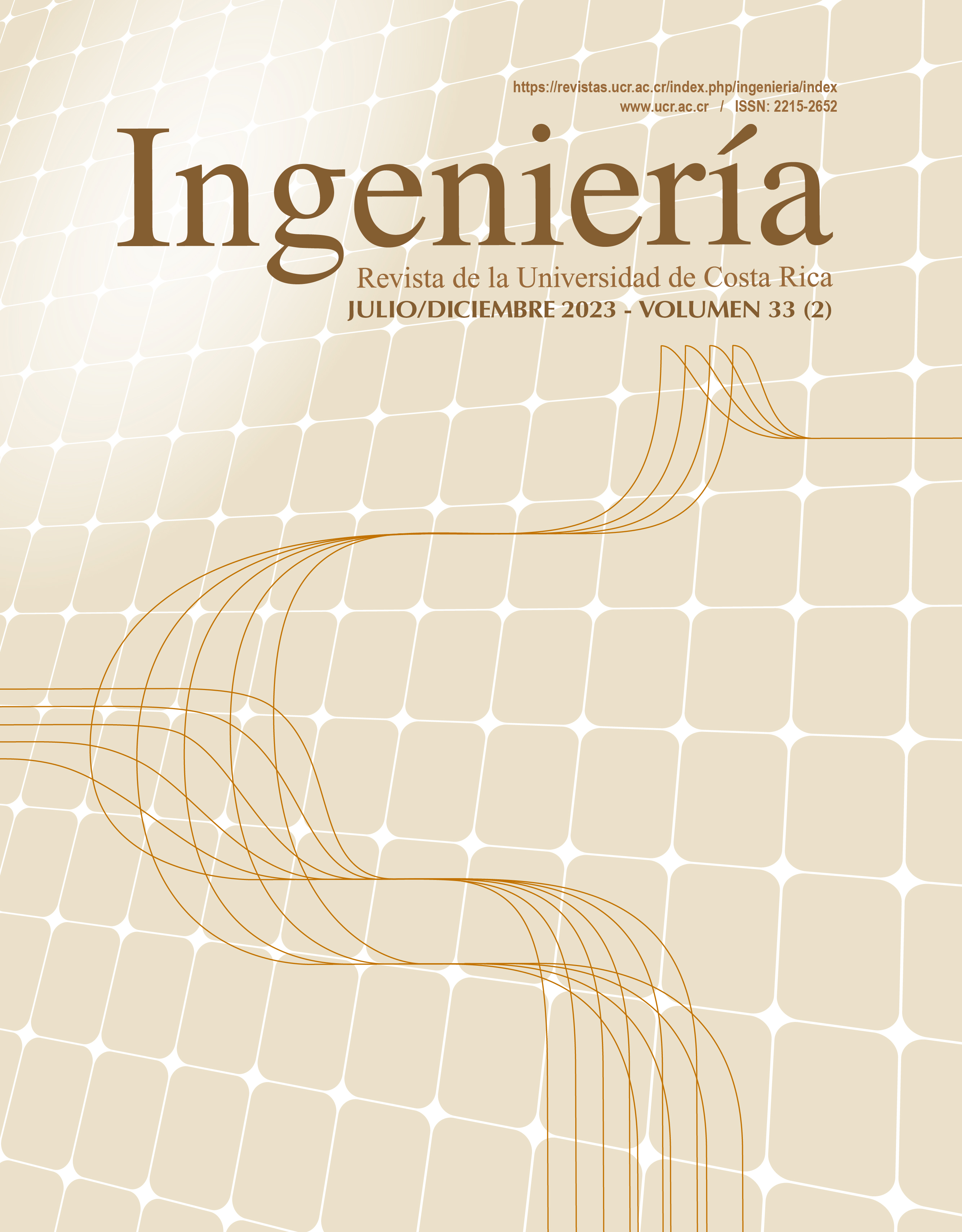Abstract
Possible surface manifestations of liquefaction were evaluated by means of severity indices, at a regional scale for the Jacó area, using information generated by 15 CPTu, estimating the seismic demand in a deterministic manner for 24 scenarios, for expected accelerations from ground motion prediction equations for Central America, considering crustal and subduction earthquakes, both intraplate and interplate. The results allow the identification of three areas where different levels of damage would be expected, depending on the seismic hazard represented in the analyzes by means of the magnitude of an earthquake and the accelerations that it could produce, and prioritize those to be investigated in greater detail for the development of private projects, public infrastructure and the location of essential buildings. The usefulness of the results is based on guiding municipal and emergency authorities to anticipate the response to the occurrence of an analysis scenario or another with intermediate conditions, knowing in advance the distribution of the sites where the damage could be greater in order to guide the immediate response and recovery efforts. It is expected that the results of this project, although preliminary, will serve as an input for the management of the risk associated with liquefaction through engineering and other measures, for purposes of land use planning and for the development of public policies for the district of Jacó, as could be a regulatory plan.
References
Asociación Costarricense de Geotecnia, Código de Cimentaciones de Costa Rica. Cartago, Costa Rica: Editorial Tecnológica de Costa Rica, 2009, p.190.
Red Sismológica Nacional, “Terremoto de Limón, 22 de abril de 1991 (en línea)”. https://rsn.ucr.ac.cr/component/content/article/26-sismologia/sismos-historicos/3235-terremoto-de-limon-22-de-abril-de-1991?Itemid=225. (accesado en Ago. 22, 2021).
Instituto Nacional de Estadísticas y Censos, “Estadísticas demográficas 2011-2025 (en línea)”. https://www.inec.cr/poblacion/estimaciones-y-proyecciones-de-poblacion (accesado en Ago. 22, 2021).
The National Academies of Sciences, Engineering and Medicine, State of the Art and Practice in the Assessment of Earthquake-Induced Soil Liquefaction and Its Consequences. Washington, DC., EEUU: The National Academies Press, 2016, p. 286.
Ministry of Business, Innovation & Employment, Planning and engineering guidance for potentially liquefaction-prone land. Wellington, Nueva Zelanda: Ministry of Business, Innonvation & Employment, 2017, p. 142.
K. Ishihara, “Stability of natural deposits during earthquakes”, en Proceedings of the 11th International Conference on Soil Mechanics and Foundation Engineering,1985, pp. 321-376.
S. van Ballegooy, R, Green, J. Lees, F. Wentz y B. Maurer. “Assessment of various CPT based liquefaction severity index frameworks relative to the Ishihara (1985) H1-H2 boundary curves”, Soil Dynamics and Earthquake Engineering, no. 79, pp. 347-364, 2015.
T. Iwasaki, F. Tatsuoka, K. Tokida y S. Yasuda. "A practical method for assessing soil liquefaction potential based on case studies at various sites in Japan”, Proceedings of the 2nd International Conference on Micro zonation, 1978, pp. 885-896.
B. Maurer, R. Green y O. Taylor. “Moving towards an improved index of assessing liquefaction hazard: lessons from historical data”, Soils and foundations, no. 55, pp. 778 - 787, 2015.
S. van Ballegooy, P. Malan, M. Jacka, V. Lacrosse, J. Leeves y J. Lyth. “Methods for characterizing effects of liquefaction in terms of damage severity”, presentado en 15th World Conference on Earthquake Engineering Lisboa, Portugal, 2012.
K. Ishihara y M. Yoshimine, “Evaluation of settlements in sand deposits following liquefaction during earthquakes”, Soil and foundations, no. 32, pp. 173-188, 1992.
G. Zhang, P. Robertson y R. Brachman. “Estimating liquefaction-induced ground settlements from CPT for level ground”, Canadian Geotechnical Journal, no. 39, pp.1168-1180, 2002.
New Zealand Geotechnical Society, Earthquake geotechnical engineering practice Module 3: Identification, assessment and mitigation of liquefaction hazards. Wellington, Nueva Zelanda: NZGS, 2016, p. 40.
R. Boulanger. y M. Idriss. CPT and SPT based liquefaction triggering procedures. California, Estados Unidos: University of California at Davis, 2014, p. 134.
Google Maps. “Mapa de Jacó, Puntarenas”. googlemaps.com. https://www.google.com/maps/place/Provincia+de+Puntarenas,+Jac%C3%B3/@9.6158125,-84.6436073,14z/data=!3m1!4b1!4m6!3m5!1s0x8fa1c76ab9610c83:0x1bf37effa58fddf6!8m2!3d9.6202396!4d-84.6217487!16zL20vMGdnMHN2. (accesado en Feb. 22, 2023).
A. Gomez, H. Madrigal, C. Nuñez, H. Calderón y P. Jiménez. “Vulnerabilidad hidrogeológica en la zona costera de Jacó, Pacífico Central, Costa Rica”, Revista Geográfica de América Central, no. 63, pp. 141-163, 2019.
Comisión Nacional de Prevención del Riesgo y Atención de Emergencias de Costa Rica, “Mapa de amenazas naturales potenciales cantón Garabito (en línea)”. https://www.cne.go.cr/reduccion_riesgo/mapas_amenzas/puntarenas.aspx (accesado en Ago. 22, 2021).
Red Sismológica Nacional, “Informe preliminar sismo de Jacó 12 de noviembre de 2017 (en línea).” https://rsn.ucr.ac.cr/actividad-sismica/sismos-historicos. (accesado en Ago. 22, 2021).
Red Sismológica Nacional, “Informe preliminar sismo de Jacó 24 de agosto de 2020 (en línea).” https://rsn.ucr.ac.cr/actividad-sismica/sismos-historicos. (accesado en Ago. 22, 2021).
R. Bogantes, G. Laporte, y C. Quesada. “Zonificación Geotécnica General de Costa Rica considerando elementos edáficos y climáticos”, presentado en VIII Seminario Nacional de Geotecnia y III Encuentro Centroamericano de Geotecnistas, San José, Costa Rica, 2002, pp. 159-181.
Laboratorio de Ingeniería Sísmica, “Estación PJAC (en línea)”. http://lis.ucr.ac.cr/1556 (accesado en Ago. 22, 2021).
A. Climent, W. Rojas, G. Alvarado y B. Benito. Proyecto Resis II Evaluación de la amenaza sísmica en Costa Rica. San José, Costa Rica: 2008. 116 p.
P. Denyer, W. Montero y G. Alvarado. Atlas tectónico de Costa Rica. San José, Costa Rica: Editorial UCR, 2009, p. 55.
Laboratorio de Ingeniería Sísmica, “Falla Herradura (en línea)”. http://www.lis.ucr.ac.cr/845 (accesado en Ago. 22, 2021).
Laboratorio de Ingeniería Sísmica, “Falla Tárcoles (en línea)”. http://www.lis.ucr.ac.cr/302 (accesado en Ago. 22, 2021).
Google Earth Pro. “Mapa de Jacó, Puntarenas”. (accesado en Feb. 22, 2023).
V. Schmidt, “Ecuaciones predictivas del movimiento del suelo para América Central, con datos de 1972 a 2010”, Revista Geológica de América Central, no. 50, pp. 7-37, 2014.
##plugins.facebook.comentarios##

This work is licensed under a Creative Commons Attribution-NonCommercial-ShareAlike 4.0 International License.
Copyright (c) 2023 Gonzalo Montalva Alvarado, Diego Alberto Cordero Carballo



